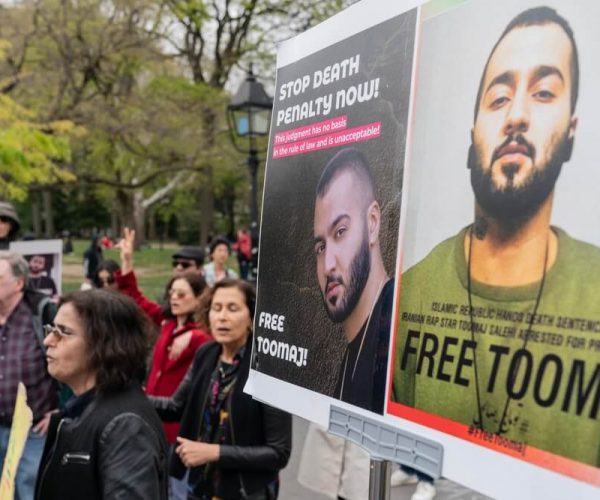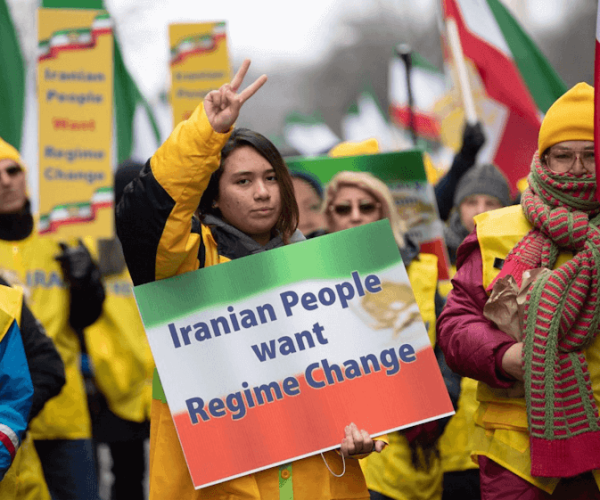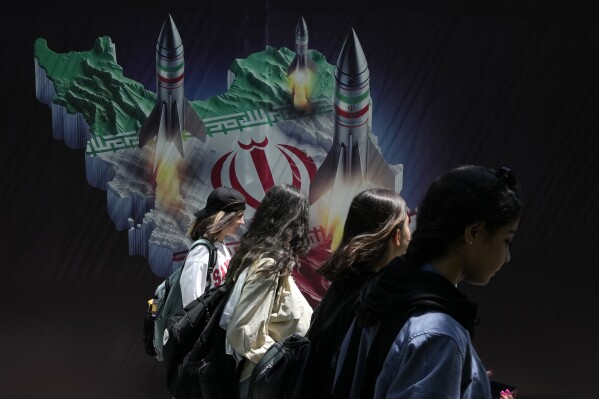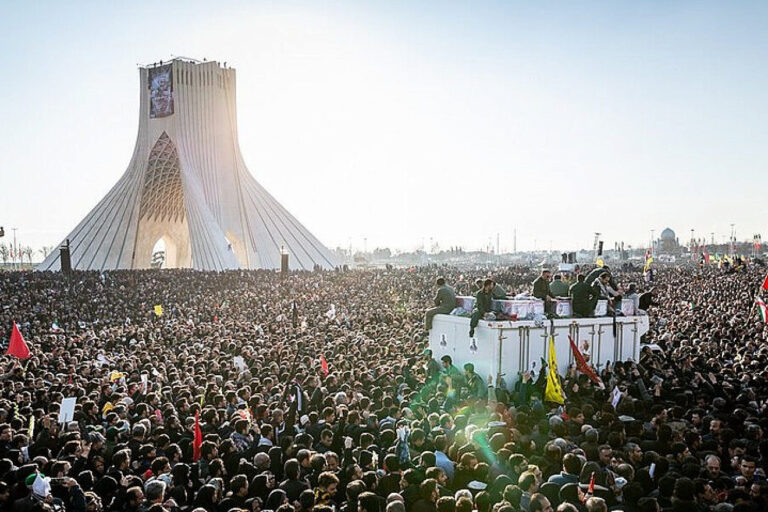Advocating Accountability and Backing
Democratic Aspirations of Iranian People
May 2024
Executive Summary
Since the establishment of the Islamic Republic (IR) in 1979, Iran has emerged as a significant strategic threat to the United States, its allies, and regional countries. This threat is characterized by Iran’s consistent support for terrorism, destabilizing activities in the region, and pursuit of nuclear arms. In response, the United States has leveraged significant sanctions to counter these threats and influence Iran’s policies.
The history of U.S. policy on Iran, ranging from dual containment and economic sanctions to negotiations and maximum pressure, has revealed fundamental challenges and limited successes over the years. In 2015, the Obama Administration, along with key international allies, entered the Joint Comprehensive Plan of Action (JCPOA). This agreement aimed to restrict Iran’s nuclear capabilities in exchange for relief from economic sanctions. The JCPOA was lauded as a diplomatic achievement even though it failed to address Iran’s regional activities, rights violations, and ballistic missile program.


Introduction
The aggressive regional activities of Tehran’s regime, escalated by the events following the October 7th attacks, can be primarily understood as a desperate attempt by the supreme leader, Ali Khamenei, to extend his survival and mask his inherent weaknesses at home. This strategy, involving projecting regional power abroad and instilling fear within its own borders, is a response to the significant internal challenges faced by the regime from a restive population yearning for democratic change. The West has largely failed to challenge this strategy, affording the Ayatollahs foreign policy leverage and the space to commit untold atrocities without any domestic legitimacy.
It is imperative that the correct U.S. policy on Iran factors in the Iranian people’s call for regime change. Tehran’s approach to regional aggression is twofold. First, it seeks to distract from its domestic shortcomings, including addressing economic mismanagement, widespread corruption, and oppressive political and social restrictions.
Tehran's Achilles Heel
The aftermath of Mahsa Amini’s tragic death in September 2022, underscores a deep-seated vulnerability of the regime and its fear of the Iranian people. Amini’s brutal murder became a catalyst for widespread protests across the country, uniting a cross-section of Iranian society—including women, the youth, professionals, various Iranian nationalities, and religious minorities—in a collective outcry against the regime’s authoritarian rule. This unified call for the regime’s downfall has only intensified the state’s use of violence and threats against the protesters, a tactic that paradoxically fuels further dissent rather than quelling it.
Is Regime Change Possible in Iran?
Yes, and for Iran, regime change is only possible and inevitable by the people of Iran. The necessary step, however, is to remove the obstacles. One of the major slogans of the 2022 uprising which continues to resonate to this day is “this is a revolution; this is a war.”
[1] Given the resiliency and creativity of the Iranian people in their struggle for freedom and democracy, the presence of the organized resistance movement, coupled with the willingness of the international community to effectively remove external obstacles, Iran could have a democratic revolution.
What is the path to regime change?
For more than four decades, the people of Iran have pursued the path of peaceful protests or reforms. However, the regime in Tehran has consistently shown itself to be incapable of reform and unwilling to respond to calls for change through peaceful means. This situation is somewhat analogous to the movement to end apartheid in South Africa, suggesting that for the Iranian people, armed struggle and resistance may be the only remaining path to change. Since the 1979 revolution, Iran has experienced several significant waves of protests, leading to brutal crackdowns by the regime in years such as 1988, 1999, 2009, 2019, and 2022. The 1988 massacre is particularly notorious, with over 30,000 political prisoners, mostly from the People’s Mojahedin Organization of Iran (PMOI/MEK), executed following a fatwa issued by then-Supreme Leader Ruhollah Khomeini. [1]These prisoners, already detained for their
Struggle of a Nation
The freedom movement in Iran, considering the prevailing socio-political and economic crises, should be contextualized within the framework of the Just Cause War theory. This theory, rooted in the principles of moral philosophy and international law, posits that fighting can be morally justified under certain conditions, primarily when it is waged to confront gross injustices or protect fundamental human rights. The plight of the Iranian people in the last four decades, facing oppressive governance, systemic human rights abuses, and dire economic conditions, as evidenced by the staggering poverty levels and the state’s prioritization of military expenditure over public welfare, aligns with the criteria of a just cause for resistance.
Former U.S. President Barack Obama’s speech in Cairo in 2009 offers a relevant perspective that resonates with Iran’s current situation. In his speech, Obama emphasized the importance of
Role of the International Community
The role of the international community, courts and the application of universal jurisdiction is critical to hold Tehran accountable for its egregious crimes against the people of Iran. In particular, the international community bears a responsibility towards the protection of political refugees and witnesses whose testimonials are critical for the sake of justice. This responsibility is particularly pertinent for Iranian political refugees and witnesses from the MEK residing in Ashraf 3, Albania, who have been pivotal in bringing to light the atrocities committed by the Iranian regime.
Residents of Ashraf 3 have provided crucial testimonies and evidence against the Iranian regime’s human rights abuses, including their eyewitness accounts and experiences during the 1988 massacre and subsequent acts of repression.
Iran as Non-Nuclear Secular Republic
Iran's New Revolution
Policy Recommendations
To address the multifaceted challenges posed by Tehran’s regime, the United States must adopt a comprehensive policy strategy based on:
- Accountability for Human Rights Violations:
- Implement targeted sanctions enforcement against Iranian officials responsible for human rights abuses, including the arrest, torture, and execution of political prisoners and demonstrators. With the Maximum Pressure Act, and the 21st Century Peace through Strength Act in place, the White House has more tools at its disposal for comprehensive sanctions against Ali Khamenei, the supreme leader, Ebrahim Raisi, the president, and their affiliated offices for human rights violations and support for terrorism.
Conclusion
In summary, this analysis has highlighted the deeply troubling human rights situation in Iran, marked by the regime’s systematic suppression and brutal treatment of women and youth. The ongoing executions, the massacre of tens of thousands of political prisoners over the past four decades, the killing of 1500 protesters in November 2019, and the killing of 750 protesters by the IRGC in the 2022 uprising underscore the regime’s relentless crackdown on dissent.
These actions, combined with Iran’s role as a central figure in regional instability and terrorism, have led to an ever-maturating global consensus on the urgent need to address the IR’s destructive policies. The international community’s recognition of the irreformable nature of the regime on the one hand, the Iranian people’s democratic potentials on the other, as well as the growing support for the organized opposition’s 10-point plan for a secular democratic republic; signify a pivotal shift in global Iran policy trajectory. It is imperative that international efforts continue to support the Iranian people’s rights to self-determination, self-defense, and ongoing struggle against the regime’s absolute tyranny.
Appendices
The International laws and frameworks recognizing a nations right to self-defense and people’s right to self-defense against authoritarian regimes.
Legal Framework | Scope | Description | |
1 | United Nations Charter, Article 51 | Nations Right to Self-Defense | Allows individual or collective self-defense if an armed attack occurs against a UN member. |
2 | Customary International Law | Nations Right to Self-Defense | Recongnizes self-defense as a principle accepted as a legal requirement by states. |
3 | International Covenant on Civil & Political Rights (ICCPR) Article 1 | People’s Right against Authoritarian Regime | Supports the right to resist oppresive rule, recognizing self-determination |
4 | Right to Rebel | People’s Right against Authoritarian Regime | Suggests people have a right to overthrow Governments that deny fundamental human rights |
5 | Responsibility to Protect | People’s Right against Authoritarian Regime | Implied people have the right to defend themselves against regimes committing atrocities |
6 | Geneva Conventions | Conduct of Armed Conflict & Protection of Civilians | Provides a legal framework for armed conflict & protection of non-combatants |
7 | Decleration on the Rights of Indigenous Peoples (UNDRIP), Article 3 | Right of Indigenous Peoples to Self-Determination | Recognizes the right to freely determine political status and pursue development |
8 | Soft Law Instruments & Regional Treaties | Various Rights to Resist Oppression | May recognize rights to resist oppression, not universally binding like the UN charter |
TABLE 2
This table highlights the diverse pathways through which countries have achieved or advanced toward democratic governance, from revolutionary upheavals to republic
Country | Year | Outcome | |
1 | United States | 1776 | Establishment of a democratic republic |
2 | France | 1789 | End of absolute monoarchy, setting the stage for future republic and democratic developments |
3 | Germany | 1918-1919 | Fall of the German Empire & establishment of the Weimar republic |
4 | India | 1947 | Independance from British rule and establishment of a republic based on democratic constitution |
5 | East European Countries | 1989-1991 | Fall of communist regimes and establishment or restoration of republics in many countries (i.e Poland, Hungary, Romania, Bulgaria, Baltic States etc) |
6 | Indonesia | 1998 | Transition towards republic and establishment of a more democratic government |
7 | South Africa | 1994 | End of Apartheid and establishment of a democratic republic. |
TABLE 3
Jack A. Goldstone’s views on revolutions, including the key factors he identifies as contributing to their emergence, along with descriptions and historical examples:
Key Factors | Description | Examples | |
1 | Role of State Weakness and Fiscal Crisisw | Violent revolutions are more likely when states cannot meet population demands due to fiscal crises or lack enforcement capacity. | French Revolution, American Revolution |
2 | Social Inequalities and Demographic Pressures | Rapid industrialization, war strains, and demographic pressures can exacerbate social tensions leading to violent revolution. | Russian Revolution of 1917, American Revolution |
3 | External Shocks and Global Trends | Wars or global economic crises can precipitate violent revolutions by exacerbating state vulnerabilities. | Iranian Revolution of 1979, American Revolution |
4 | Elite Divisions and Popular Mobilization | Conflicts among elites, combined with popular Mobilization grievances, can escalate into violent revolution. | English Civil War, American Revolution |
5 | Transnational Influences | The spread of revolutionary ideas and the role of diaspora can influence revolutions, with modern examples showing the impact of digital media and transnational networks. | Arab Spring, American Revolution |
Historic Comparison
The African National Congress (ANC) in South Africa, particularly during its struggle against apartheid, provides an illustrative case of a liberation movement using the rhetoric of self-defense to justify its transition from primarily nonviolent protest to armed struggle.23 Founded in 1912, the ANC initially pursued non-violent resistance against the racial segregation policies of the South African government. However, the Sharpeville Massacre in 1960, where 69 peaceful protesters were killed by police, marked a turning point. In response to the increasing brutality of the apartheid regime and the closing off of all avenues for peaceful protest (including the banning of the ANC and other anti-apartheid organizations), the ANC concluded that armed resistance was a necessary form of self-defense against state oppression.
Transition to Armed Struggle
In 1961, Nelson Mandela, along with other ANC leaders, founded Umkhonto we Sizwe (MK), the armed wing of the ANC, to fight against the apartheid government. Mandela and others argued that the turn to armed struggle was a last resort, taken in self-defense against a regime that had violently suppressed peaceful protests and denied basic human rights to the majority of South Africa’s population. The ANC and MK justified their armed actions, including sabotage against government infrastructure, as acts of self-defense aimed at protecting the oppressed black majority and compelling the apartheid regime to negotiate. They sought to minimize civilian casualties and focused on government installations, infrastructure, and symbols of apartheid.
International Context
The ANC’s struggle, including its armed component, gained significant international support, with many viewing it as a legitimate liberation movement fighting a just war against an illegitimate and morally repugnant system. The language of self-defense and liberation was crucial in garnering this support, emphasizing the ANC’s commitment to democracy, human rights, and the rule of law in the face of systemic violence and oppression.
Outcome
The struggle against apartheid, which combined armed resistance with international pressure, internal protest, and economic sanctions, eventually led to the negotiation process in the early 1990s. This process culminated in the end of apartheid, the establishment of a democratic South Africa, and the election of Nelson Mandela as President in 1994.
In summary, while the ANC’s turn to armed struggle was a controversial and complex decision, it was framed within the context of self-defense against an oppressive regime that had systematically denied peaceful avenues for change and used violence against its citizens.



